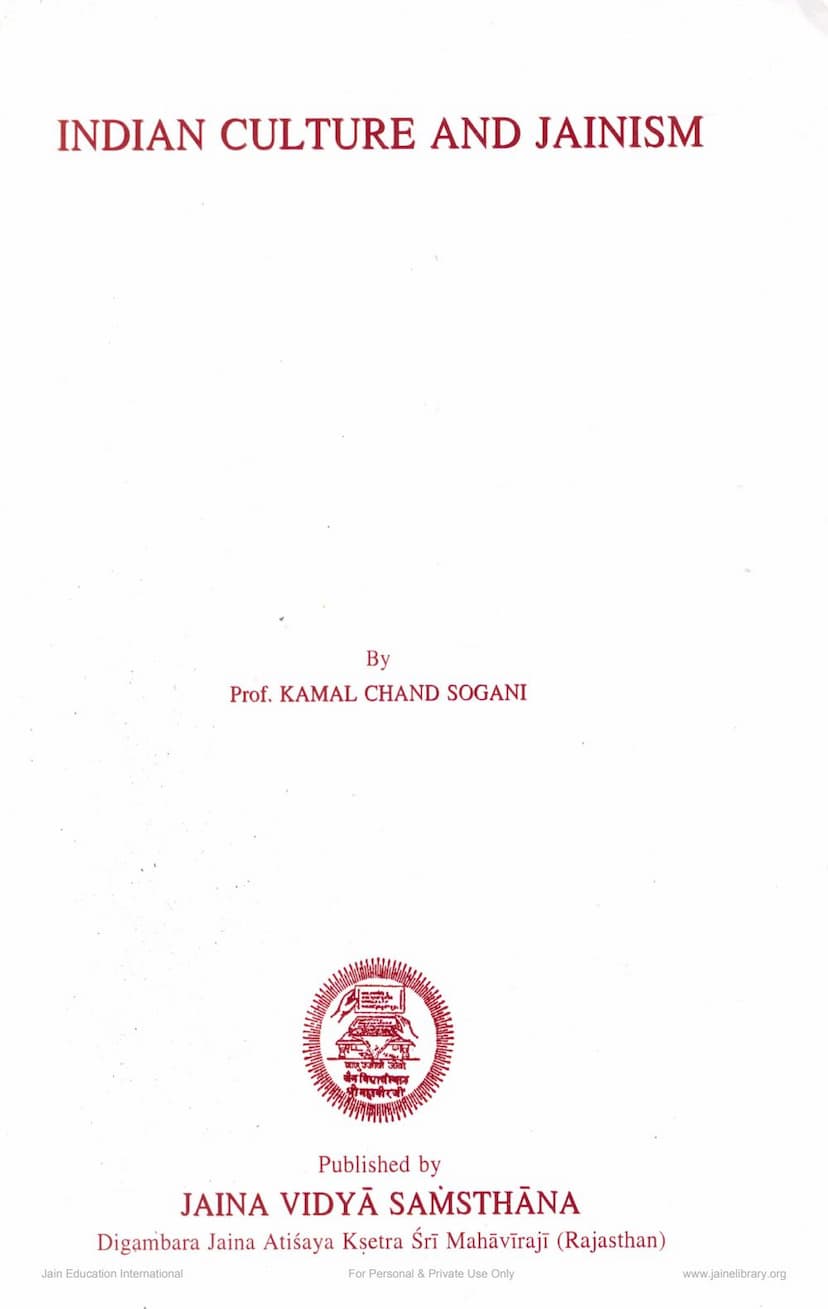Indian Culture And Jainism
Added to library: September 1, 2025

Summary
Here is a comprehensive summary of the Jain text "Indian Culture and Jainism" by Prof. Kamalchand Sogani:
The book "Indian Culture and Jainism" by Prof. Kamalchand Sogani explores the profound and intricate relationship between Jainism and the broader tapestry of Indian culture. The author argues that Indian culture is a synthesis of Vedic and non-Vedic (Śramana) traditions, and Jainism, as a prominent Śramana tradition, has played a significant role in shaping this culture.
Key Themes and Arguments:
-
Jainism as a continuation of Śramana Culture: The text posits that Jainism, with its twenty-four Tirthankaras, headed by Rishabhanatha (also known as Adinatha), represents a continuation of the ancient Śramana culture. Archaeological evidence, particularly from the Indus Valley Civilization (Mohenjodaro and Harappa), suggests the presence of Śramanic elements like the bull symbol (associated with Rishabhanatha), nudity, and the Kayotsarga (meditative standing posture), indicating a possible pre-Vedic origin for Śramanism and Jainism. The author notes that the anti-ritualistic tendencies within the Vedic fold might also be attributed to the impact of this asceticism.
-
Rishabhanatha and Early Indian Civilization: Rishabhanatha, the first Tirthankara, is presented as a foundational figure who is credited with establishing social order, promoting agriculture, arts, crafts, and writing. His influence is seen in Brahmanical texts where he is considered an incarnation of Vishnu. The ancient Brahmi script is also named after his daughter, Brahmi. The book highlights that India itself is known as "Bharat" after Bharata Chakravarti, son of Rishabhanatha, as recorded in various Puranas, countering the common attribution to Bharata, son of Shakuntala.
-
Mahavira's Teachings and their Impact: The text focuses on Lord Mahavira, the 24th Tirthankara, and his teachings. It mentions his first sermon delivered after a period of silence, to a Vedic Brahmin scholar named Indrabhuti Gautama. A crucial point is Mahavira's use of Prakrit for his discourses, making his teachings accessible to the masses, transcending caste and creed. This choice of language also underscores the author's argument about the linguistic connections between Vedic Sanskrit and Prakrit. Mahavira's religion is characterized as Sarvodaya-Tirtha (a pilgrimage for the welfare of all), a concept later popularized by Mahatma Gandhi. Mahavira's impact extended to social reform, fighting exploitation, and promoting individual liberty alongside spiritual upliftment. His nirvana is linked to the Diwali festival, and the Vira Nirvana Samvat is noted as the oldest Indian calendar.
-
Unprecedented Contributions of Jainism to Indian Culture: The book elaborates on several significant contributions of Jainism:
- Ahimsa and Aparigraha: The doctrine of Ahimsa (non-violence) is central, extending to all living beings and viewed both as a social and spiritual principle. The classification of living beings based on senses is explained as a basis for understanding degrees of violence. Aparigraha (non-possession/non-attachment) is presented as a solution to economic inequality and exploitation.
- Paryaya (Modification) in Substance: Jain metaphysics defines substance (Dravya) as that which persists through change. The concept of Paryaya (modes or modifications) is crucial, explaining how a substance remains the same while its attributes change. This contrasts with Buddhist and Vedantic views. The spiritual implication lies in distinguishing between essential (Svabhava) and non-essential (Vibhava) modifications of the self, advocating for the cultivation of essential ones.
- Anekanta and Naya: The theory of Anekanta (many-sidedness of reality) posits that reality is complex and cannot be understood from a single viewpoint. This metaphysical doctrine is complemented by the Naya (viewpoint) system, which allows for understanding different aspects of reality without contradiction. Syadvada, the doctrine of conditional predication, is the linguistic expression of Anekanta, providing a way to communicate knowledge accurately by acknowledging the multifaceted nature of things. The Saptabhangi (seven-fold logic) illustrates this principle.
- Doctrine of Karma: Jainism explains individual differences in cognition, conation, and affection through the doctrine of Karma. The eight types of Karma are described, detailing how they bind the soul and influence its experiences.
- Mystical Journey: The text outlines the spiritual journey in Jainism, often expressed through terms like Śuddhopayoga and the attainment of Arhat and Siddha states. This journey is mapped through the fourteen Gunasthānas (stages of spiritual evolution), encompassing awakening, purgation, illumination, and transcendental life.
- Tri-ratna (Three Jewels): The composite practice of Samyagdarśana (right faith/perception), Samyagjñāna (right knowledge), and Samyakcāritra (right conduct) is presented as the path to emancipation (Moksha).
- Religious Freedom for Women and Downtrodden: Mahavira is highlighted for granting religious freedom to women and admitting them into the monastic order. The text also emphasizes his principle of social equality, basing societal division on activities rather than birth, and advocating for the dignity of all individuals, irrespective of caste or creed.
- Vegetarianism and Defensive War: Jainism promotes vegetarianism as a way to minimize Himsā. The concept of defensive Himsā is also discussed, acknowledging the necessity of self-defense in certain situations while advocating for minimizing harm.
- Sallekhana: The practice of Sallekhana (spiritual acceptance of death) is described as a dignified and peaceful way to renounce the body when death is imminent, distinguished from suicide.
-
Jaina Art and Literature: The book also touches upon the significant contributions of Jainism to Indian art and literature. Jaina art is seen as purposive, aiming to convey ethico-spiritual messages, and is expressed through cave architecture, temples, pillars, and paintings. Jain literature, primarily in Prakrit, but also in Apabhramśa, Kannada, and Tamil, has immensely enriched India's literary heritage, with notable works and contributions to grammar, logic, and philosophy.
In essence, Prof. Sogani's work argues that Jainism is not merely a religion but a vital stream that has deeply influenced the philosophical, ethical, social, artistic, and linguistic landscape of India, contributing significantly to the richness and diversity of Indian culture.